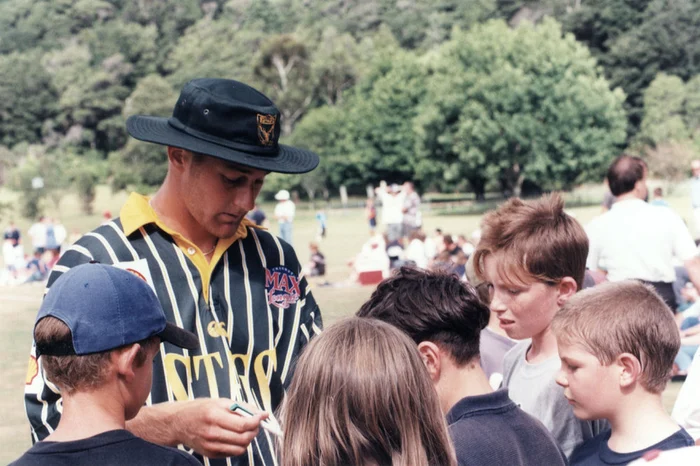Carl took his cricketing skills to the Max

In cricketing circles, it is often said that ‘catches win matches’. However, some catches have wider implications than others.
In Marlborough cricketer Carl Bulfin’s case one particular catch, taken off his lively pace bowling, was to have a very significant outcome - not only on his career, but also his life.
The year was 1996; the catcher, at slip, was Black Caps batsman Mark Greatbatch. The occasion was a two-day friendly match between a Marlborough Invitation side and Nelson at Horton Park and the catch would ultimately launch the then 23-year-old painter and decorator onto the world cricket stage.
Carl takes up the story.
“Mark was standing at second slip and I was bowling to [former NZ batsman] Mark Douglas. I found the edge of Dougies’s bat and ‘Batch’ caught it. Next thing I know he says, ‘we’ve got this new Cricket Max competition in Christchurch coming up and you look the goods boy’.
“He must have put in a good word with the selectors because next thing I was in the Central Districts Max side. It was a weekend in Hagley Park with all six first-class teams there … in my debut match against Northern Districts I got 4-11, my best-ever figures. They only needed 70 in the second innings and I ran through them like a dose of salts,” he recalled with a chuckle. “That immediately gave me confidence and I felt I belonged at that level.”
“We really enjoyed [Max cricket], it was different,” said Carl. “As a bowler you only had to bowl 24 balls so you would try to bowl 24 yorkers and, if you got them on the money, you generally got wickets.”
CD, buoyed by Bulfin’s bullets, won that tournament and the final in Hamilton the following weekend. Then a Max league was formed, players participating in the Shell Cup one-day competition before taking part in a Max match the following evening against the same opposition.
Carl’s raw talent gained him a spot in the CD one-day side, his blonde dreadlocks and fiery pace bowling quickly earning something of a cult following around the country, especially in the Martin Crowe-inspired Cricket Max format.
It was a hugely-innovative concept, the forerunner of Twenty20 cricket, and included some radical tweaks to previous cricketing norms.
Games were completed in just three hours (creating a perfect TV package), free hits were introduced, plus decent prize money, animated umpiring signals became commonplace (initiated by the legendary Billy Bowden), regular floodlit matches were played for the first time in this country and drop-in pitches were utilised.
Setting Max cricket apart from T20 was the fact two 10-over innings were played and the Max zone was introduced, with any runs scored in that area counting double.
As the game began to take off nationally, Carl’s profile soared.
In 1997, an English Lions side toured the country and the first New Zealand Max Blacks team was chosen. Carl was included, among a relatively unproven bunch at international level, led by Roger Twose.

Carl recalls that historic first series.
“We played [the Lions] first-up at Ericsson Stadium under lights on an artificial wicket which was an interesting proposition. We lost there but won in Hamilton and went to a decider in Wellington, which we won.”
Carl bowled well to claim two wickets for a meagre 15 runs in the decider, but even better things were to come in his fourth, and what proved to be his final international Max fixture.
The following season, the West Indies opened their NZ tour with a game of Max at Lancaster Park in Christchurch and it became a night to remember for the young Marlburian.
The Max Blacks took a 46-run first innings lead, built around captain Twose's seven-ball 43 and Chris Cairns' comparatively sedate 17-ball 44.
The Carl stepped up, claiming the first Max hat-trick with the notable scalps of Windies’ stars Brian Lara, Shivnarine Chanderpaul and Sherwin Campbell in consecutive deliveries.
“It was in the second innings, the second-to-last over … I got Lara with a slower ball which he hit in the air, then I cleaned out Chanderpaul with a yorker and flicked Campbell’s gloves on the way through to the keeper with the third ball. Everyone ran in and someone said, ‘was that a hat-trick?’ and I said ‘bloody oath it was’. It was pretty neat.”

Carl had opted for the dreadlocked look, courtesy of Blenheim hairdresser Sharee Stark, before he sprang to prominence. However, the flowing locks, and the fact he sometimes bowled in wraparound sunglasses, helped lift his profile to a new level.
“The kids loved [the dreads],” recalls Carl. “I even had my own bloody fan club in south Taranaki. They wore mops on their heads and were a good bunch of lads.”
As for the sunglasses, well they were not there just to avoid glare. “Adidas asked me if I wanted some glasses and I said, ‘how about some money as well if I wear them when I bowl?’, and they came to the party,” explained Carl.
He went on to play first class cricket for CD and Wellington and represented New Zealand in four one-day internationals, including a World Cup match in 1999.
However, it will be his Cricket Max heroics that Carl is best remembered for.
The dreadlocked tearaway paid tribute to local identities Tony Kilmartin, from the Celtic club, and former international speedster Gary Bartlett for helping him make the most of his potential.
“Tony was there in the earlier days, he helped with my run-up, action and fitness and Gary took it from there.
“He was all about hitting the crease hard and helped me manage my injuries … he said if you got your rhythm right then things were going to happen for you, which nine times out of 10 they did.”
There are plenty of batsmen, across all levels of the game, who will vouch for that.
